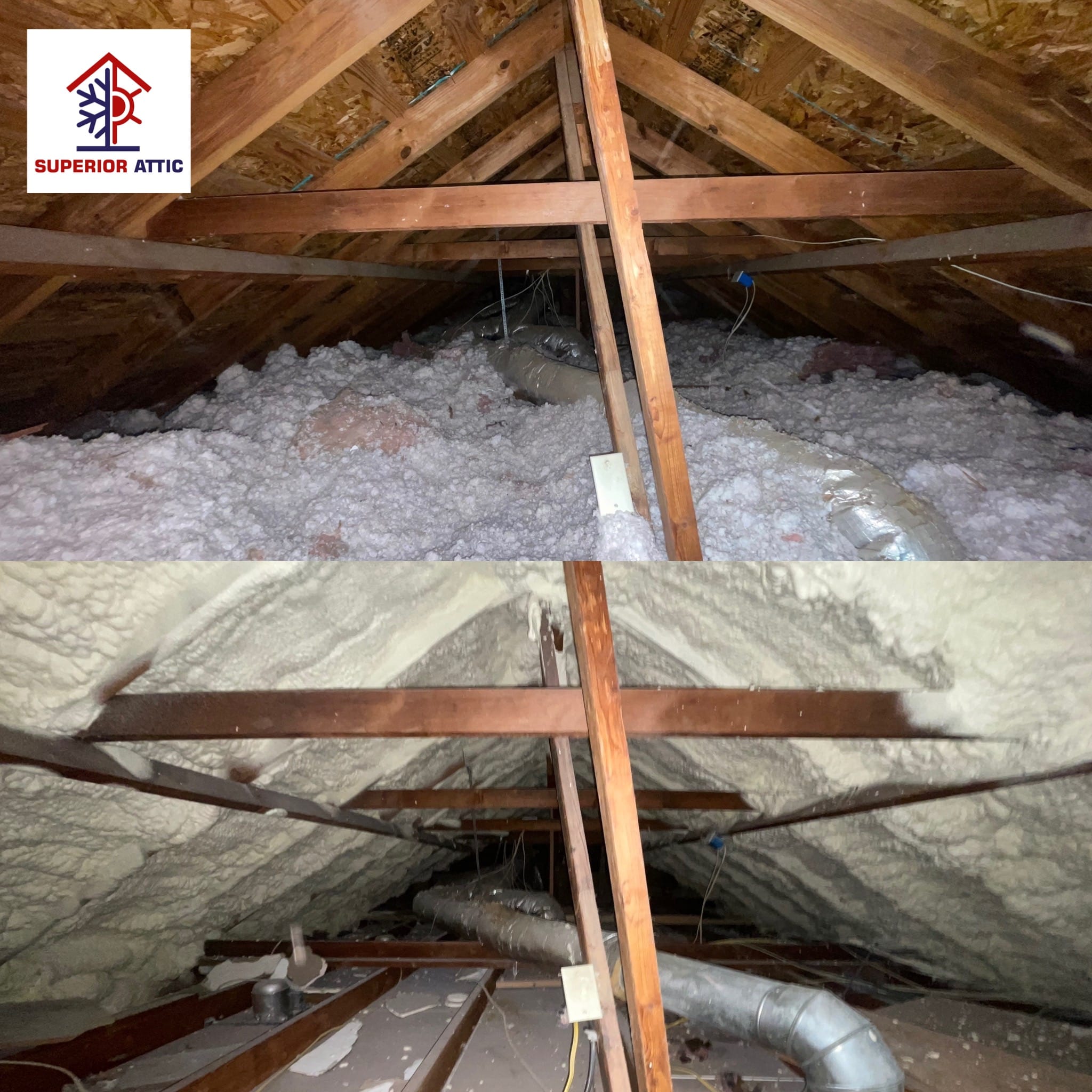Spray Foam Vs Blow-In Insulation
Struggling To Decide If Blown-In Insulation Or Spray Foam Attic Insulation Is Better For Your Home? We'll Look At The Pros And Cons Of Each To Help You Make The Right Choice.
Struggling to decide if blown-in insulation or spray foam attic insulation is better for your home? We'll look at the pros and cons of each to help you make the right choice.
Blow-in insulation vs. spray foam: is there any competition when both types of insulation keep your indoor temperatures cool on hot days and warm on cold days? Is there any debate when both stop your heated and cooled air from leaking out? Both spray foam insulation and blown-in insulation are crucial to your home's energy efficiency. Let's look at their descriptions and pros and cons to set them apart.
What Is Spray Foam Insulation?
Spray foam insulation or spray polyurethane foam (SPF) is a liquid chemical that certified attic specialists apply with either a spray foam gun or a spray can. As the name and application suggest, it is a kind of spray-in insulation or sprayed insulation that expands up to an inch thick to form an airtight seal over holes and cracks that air and moisture could pass through.
Spray foam comes in two types: closed cell spray and open cell spray. Closed cell spray foam has cells that are fully closed off. These closed cells compress against each other to prevent moisture and air from flowing through, making closed cell spray foam dense and rigid when applied.
Open cell spray foam is comprised of cells that aren't entirely enclosed and pressed against one another, making the foam soft and flexible when sprayed.
Pros Of Spray Foam
- Certified attic specialists install spray foam to the attic roofline and walls, freeing up your attic floor for walking in or storing items.
- Spray foam has been a popular attic insulation option because of its heightened R-values. You can expect an outstanding thermal performance from insulation with a high R-value. Closed-cell spray foam can reach R-values of up to 7.0.
- Spray foam insulation doesn't settle or sag over time.
- It is relatively moisture-resistant, which keeps mold at bay.
Cons Of Spray Foam
- Blown-in cellulose vs. spray foam? The number one issue with spray foam insulation is cost. It is up to 4 times more expensive than blown-in fiberglass or cellulose.
- Spray foam insulation contains a dangerous chemical called isocyanates. If isocyanates stay sealed inside the spray foam insulation and you had a professional insulation installation, it's not usually a cause for concern. But if you DIY and improperly install spray foam, harmful contaminants might settle on surfaces elsewhere in your home and become the source of unpleasant smells and health risks. Isocyanate exposure can lead to occupational asthma, difficulty breathing, chest tightness, and irritation of the skin and mucous membranes.
- Spray foam is the most flammable of all types of insulation.
What Is Blown-In Insulation?
What is blown-in insulation? Spray foam insulation utilizes spray cans and spray foam guns whereas certified attic specialists use insulation blowers or blowing machines for this style of insulation installation.
What is blown-in insulation made of? The two most widely used blown-in insulating materials are cellulose and fiberglass. Manufacturers make both blown-in cellulose insulation and blown-in fiberglass insulation (or loose-fill fiberglass) with recycled materials.
Pros Of Blown-In Insulation
- Blown-in insulation is excellent at filling all gaps and giving you a good, complete insulation layer.
- Because blown-in insulation creates an airtight seal, it lessens outside noise.
- Blown-in insulation is generally uncomplicated to install, primarily if you recruit the services of certified attic specialists.
- Blown-in fiberglass insulation is a fire retardant.
- It creates an airtight seal across the attic; uncontrolled air can't pass through the small spaces.
- Blown cellulose vs. spray foam? Blown cellulose or blow-in insulation is much quicker to install in houses already standing. Your drywall will remain untouched. This minimal invasiveness saves you money and time.
- Eighty-five percent of Americans favor blown-in insulation because it is effective but inexpensive.
- Blown-in fiberglass is an excellent choice for homeowners looking to reinforce their old insulation. Consult with a certified attic specialist to fully maximize the benefits.
- It's best for filling in the tight gaps around wiring and pipes. Blown-in insulation is also the prime choice for irregularly-shaped attics with low ceilings, hard-to-reach spaces, and for navigating multiple obstructions.
Cons Of Blown-In Insulation
- When inhaled or touched, the glass fibers of fiberglass insulation can irritate the skin and lungs. When handling fiberglass, it's best to wear dust masks, gloves, long sleeves, pants, and Personal Protective Equipment (PPE).
- Fiberglass particles could enter the home air supply when incorrectly installed.
- It needs to be replaced every 20-30 years.
Picking Between The Two
In this match-up, spray foam might initially look superior to blown-in insulation in terms of R-values and longevity. But choosing home insulation shouldn't be based on R-values alone. It is still best to discuss with a certified attic specialist your overall budget, all health & safety hazards, the climate of your location, and the area in your home you will be insulating. Based on these factors, they will be able to recommend whether blown-in or foam insulation is right for you and your home in the long term.

